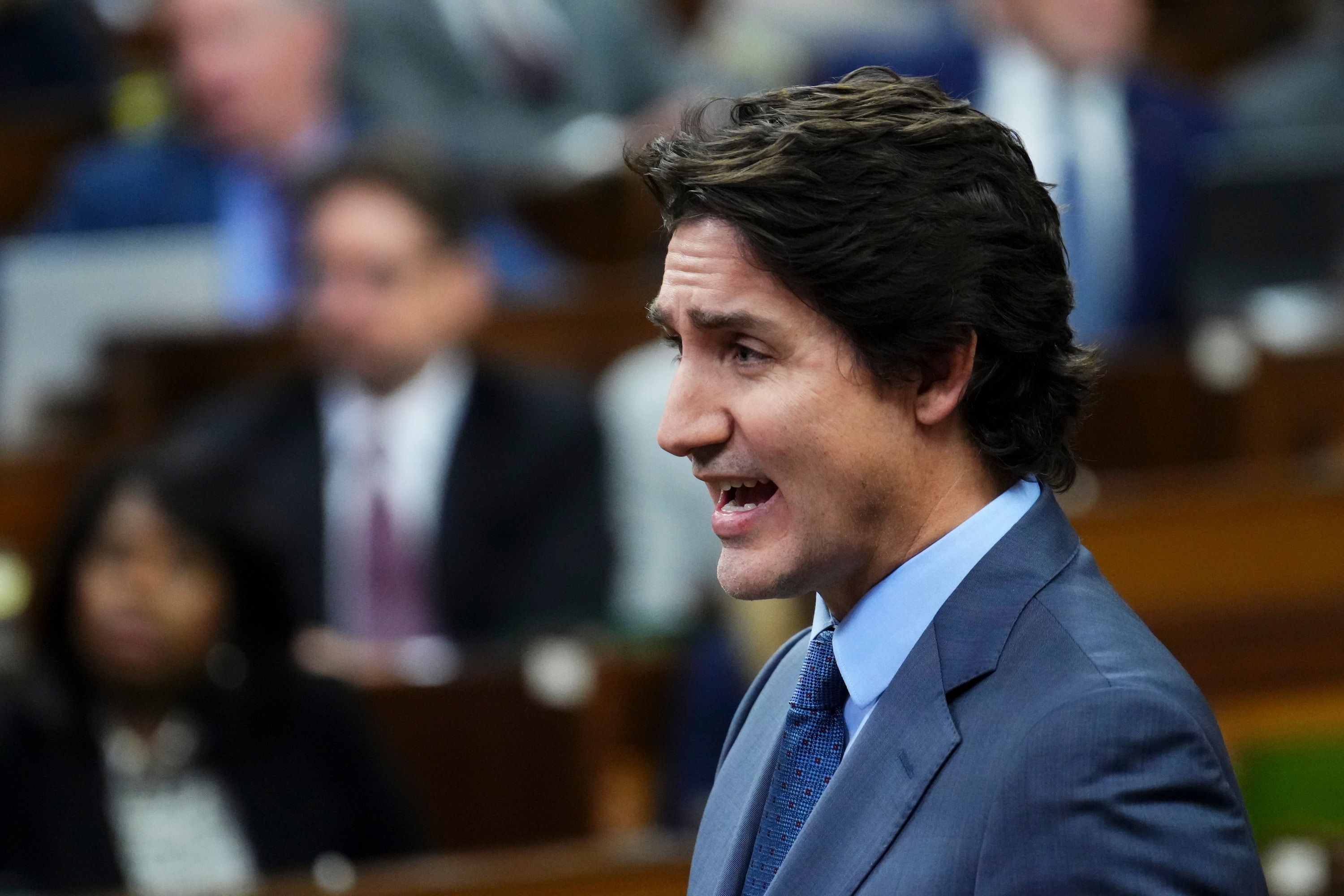Smith says Alberta's CPP exit campaign to continue despite questions over key number
HEAD STRONG & BAT SHIT CRAZY
THIS IS THE CHILEAN PRIVATIZATION OF STATE PENSION PLAN PROMOTED BY THE OLD REFORM PARTY

EDMONTON — Premier Danielle Smith says Alberta will continue its $7.5-million pension-exit advertising and survey campaign, despite acknowledging the key dollar figure is disputed and likely headed to court.
Smith says her government stands by its assertion that Alberta deserves $334 billion if it leaves the Canada Pension Plan — a figure that represents more than half of all CPP assets.
Smith says the number stands because it’s the only number out there.
“We've asked the federal government to give us their interpretation. They declined,” Smith told reporters in Calgary on Thursday.
“We've asked the CPP Investment Board to give us their interpretation, it declined.
“So maybe the next step is to go to court to see if the court supports our interpretation.”
Related video: Finance ministers to meet on Alberta's proposal to leave Canada Pension Plan (The Canadian Press) Duration 2:57 View on Watch
Smith reiterated comments she made a day earlier in Edmonton that until that transfer number is nailed down, she will not ask Albertans to vote in a referendum on leaving the CPP.
“We will have a firm number before we go into a referendum,” Smith said.
“Albertans want to know what the number will be.
“The amount of the asset transferred will then determine how much we can reduce premiums or it will determine how much we can increase benefits.”
Opposition NDP Leader Rachel Notley said it’s time for Smith’s government to stop altogether with its yo-yo messaging.
“Two days ago, the premier and I think (pension engagement panel chairman) Jim Dinning were completely confident that the ($334-billion) number was a good number,” Notley told reporters Thursday in Calgary.
“Yesterday, they started to show what all the rest of us know, which is that it's a ridiculous number.
“Today it's back to being a good number.”
Notley added, “At the end of the day, what is happening is Albertans’ money is being spent in a campaign full of misinformation and lies in order to persuade Albertans to let Danielle Smith and the UCP (government) have access to their retirement savings.”
For the past month, Smith’s government has been expounding in ads and an online survey the benefits that could come to Albertans with a $334-billion transfer from the CPP. That would include lower premiums, higher pensions and perhaps thousands of dollars in bonus payments to seniors.
Economists and the Canada Pension Plan Investment Board say the amount Alberta would get would be, at best, half that amount and likely lower.
The Canada Pension Plan Investment Board pegs Alberta’s share of the CPP at 16 per cent.
University of Calgary economist Trevor Tombe, whose research on this topic has been cited by Dinning, puts the figure at about 20 per cent.
Alberta represents about 15 per cent of the people who contribute to CPP.
The advertising campaign and the online survey have come under fire from the NDP, the Canada Pension Plan board and from some callers on Dinning’s two recent telephone town halls.
They note the survey doesn't ask Albertans if they want to leave the CPP, but instead only asks them how they would like an Alberta plan structured.
The advertising trumpets the benefits of a government-commissioned report from analyst LifeWorks — which computed the $334-billion figure — but avoids mentioning the potential risks and downsides also flagged by LifeWorks.
Smith is slated to get a report from Dinning next spring on what Albertans think about a provincial pension plan.
She is then tentatively slated to make a decision on whether there is enough public interest in an Alberta pension plan to take it to referendum, with that vote possibly coming in 2025.
In recent days, the issue has garnered national attention.
On Wednesday, federal Finance Minister Chrystia Freeland agreed to convene a meeting with provincial and territorial finance ministers to discuss Alberta's CPP-exit proposal.
The decision came after Ontario Finance Minister Peter Bethlenfalvy called for a meeting in a letter to Freeland, saying Alberta's withdrawal could cause "serious harm over the long term to working people and retirees in Ontario and across Canada.''
Last week, Prime Minister Justin Trudeau said his government will fight to retain the stability and integrity of the CPP, while Conservative Leader Pierre Poilievre encouraged Albertans to stay in the federal nest-egg fund.
This report by The Canadian Press was first published Oct. 26, 2023.
Dean Bennett, The Canadian Press
The Evolution of the Canadian Pension Model - World Bank Doc...
https://documents1.worldbank.org/curated/en/780721510639698502/pdf/121375-The-Evolution-of-the-Canadian-Pension-Model-All-Pages-Final-Low-Res-9-10-2018.pdf
to the Canada Pension Plan and ongoing reforms to improve the governance and ... larger public sector plans, offering third-party asset management services ...
Ontario Pension Policy Making and the Politics of CPP Reform, 1963–2016
Published online by Cambridge University Press: 27 November 2019
Benjamin Christensen[Opens in a new window]
Show author details
Article
Metrics
Get accessShare
Cite
Rights & Permissions[Opens in a new window]
Abstract
After years of pension policy drift in a broader context of global austerity, the Canada Pension Plan (CPP) was enhanced for the first time in 2016 to expand benefits for Canadian workers. This article examines Ontario's central role in these reforms. The deteriorating condition of workplace plans, coupled with rising retirement income insecurity across the province's labour force, generated new sources of negative feedback at the provincial level, fuelling Ontario's campaign for CPP reform beginning in the late 2000s. The political limits of policy drift and layering at the provincial level is considered in relationship to policy making at the national level. As shown, a new period of pension politics emerged in Canada after 2009, in which the historical legacy of CPP's joint governance structure led to a dynamic of “collusive benchmarking,” shaped in large part by political efforts of the Ontario government, leading to CPP enhancement.
Canada: Manitoba enacts Pension Benefits Act reforms


Contributor
Jared Mickall
Principal, Mercer Wealth

Contributor
Stephanie Rosseau
Principal, Mercer’s Law & Policy Group

Contributor
Fiona Webster
Principal, Mercer’s Law & Policy Group
August 31, 2021
Reforms to Manitoba’s Pension Benefits Act and accompanying regulations (Bill 8 and Regulation 63/2021) with a proclamation date of 1 Oct 2021, modernize the law, create a framework that protects individuals in times of financial hardship, and provide greater and easier access to locked-in funds.
Highlights
Plan participation after normal retirement. Pension plans may permit an active member who has reached the plan’s normal retirement age to stop contributing to the plan and accruing benefits. At actual retirement, for defined benefit pension plans, the member will be entitled to receive at least the actuarial equivalent value of the defined benefit pension that would have been paid if the member had retired at the normal retirement age.
Division of pension assets in event of relationship breakdown. Parties will be able to divide pension assets up to 50%, rather than choosing between the currently mandated 50-50 split or no division.
Unlocking fundsIndividuals who have reached age 65 will be allowed to fully unlock their Manitoba locked-in accounts held by a financial institution, subject to certain limitations.
A one-time 50% unlocking of a person’s pension funds after age 55 and prior to age 65 is still permitted; however, the Superintendent will no longer be required to approve such requests.
Individuals undergoing prescribed hardship will be able to unlock all or part of their Manitoba locked-in accounts held by a financial institution, subject to certain limitations.
Other changes. The legislation also addresses the filling of a nonactive voting representative on a pension committee, allows for specified multiemployer plans, clarifies the application of specific provisions, and includes other housekeeping changes.
Related resourcesNews release (Government, 17 Aug 2021)
Bill 8 (Government)
Regulation 63/2021 (Government)

No comments:
Post a Comment